Aunt Mary and the Hinman Place
Did you ever have a place you thought was magical during your childhood?
The current story prompt is "Select your favorite room in the house and write a description of the physical details and why this room was your favorite." I just finished writing about one of my favorite places in the world, my Great-Aunt Mary's home near Chillicothe, Ohio, which I'll share instead.
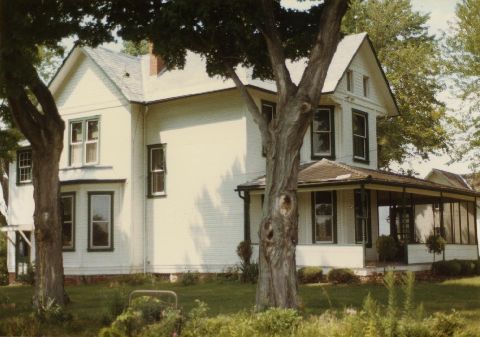
The Hinman Place, circa 1985
I loved our visits to (Great) Aunt Mary’s home out in the country during the summers I stayed with my grandmother as a child; going to her house was always a treat as well as an adventure. When Aunt Mary was a teenager she moved along with her parents to a farm north of Chillicothe, where, it turns out, she ended up living the better part of her 98 years. It was a wonderful old house built in 1880, made of white wooden clapboards with dark green trim, designed with all sorts of interesting nooks and crannies and featuring the architectural details common in big places with a tendency toward amplitude. Among these were huge pocket doors, a front door containing a very pretty leaded, beveled piece of art glass and a bridal staircase. The “Hinman Place,” as it was known, was not a mansion; it was not especially formal or pretentious and grand in the manner many fine old houses are, but it certainly could match them in size. It was a comfortable sort of house, one built for family living rather than built just for show. It stood next to several outbuildings also constructed of white frame with green trim, amongst them a milk-house with an upstairs studio, a large carriage house-turned-garage and beyond that a barn.
One feature that stands out in my memory is the large, wraparound porch that stretched across the front and side of the house. Aunt Mary kept marvelously comfortable (and sturdy) turn-of-the-century wicker furniture painted dark green and covered in bold floral and striped fabrics of the kind popular in the 1920s and 1930s on this porch. There was also a sofa on rockers. The floor of this porch was painted with shiny, gunmetal gray enamel. Its inner walls, of course, were the white clapboards on the exterior of the house and its outer walls were entirely covered in screen. One article I liked very much was a pottery vase made to hold flowers that was created to be flat on one site so it could be hung on a wall. This vase was by the side door leading from the porch to the living room and usually contained several decorative stalks of dried wheat.
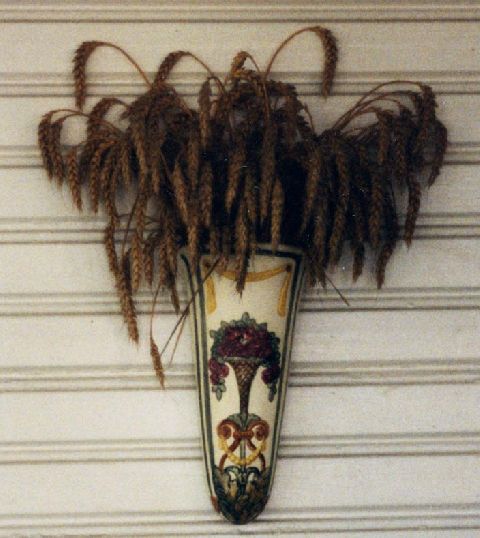
The ceramic wall-hung vase that always sat on the porch wall by the living room door. When she was young Aunt Mary did ceramics, so I suspect she must have made this vase herself when she was a teenager.
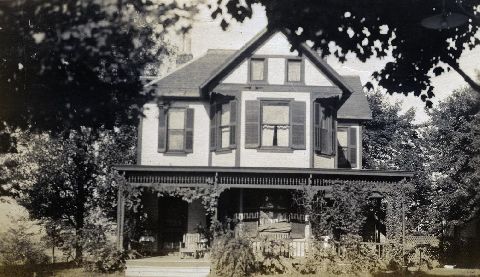
Hinman Place as it appeared circa 1920
Hinman Place sat right on State Road 159, so the sound of cars zooming by was quite noticeable not only when sitting on Aunt Mary’s big old porch, but also in the front-facing rooms of the house. Her yard was enclosed by an old, decorative iron fence. The best thing about this yard was the old iron pump, which all we cousins loved to crank up and down repeatedly in the act of “priming,” a process that never failed to produce a series of distinctive squeaks followed, after a minute or so, by a stream of cool, metallic-tasting water we’d catch in a tin cup affixed to the pump.

The "Waltons"- style telephone in Aunt Mary's kitchen
Aunt Mary’s house was as unchanging as the Great Pyramids. Nothing new was purchased or made use of if the original still functioned. The rooms in her house fascinated me and were probably the basis for my life-long love of old houses and antiques. The best example of this was the old wooden wall-hung telephone in the kitchen which still, as late as the 1950s and early 1960s, had to be cranked just like the one on the set of “The Waltons,” even though the kitchen itself had been updated in the early ‘50s. It was the only remotely “modern” room in the house, the only room I found unremarkable, save for a breathtakingly beautiful view of an unusually picturesque plot of farmland to be seen from the west-facing window over the kitchen sink. I loved exploring the house and took advantage of the long gab sessions betwixt the grownups on the porch to run up and down the stairs, darting in and out of Aunt Mary’s rooms at will. Looking back on it, this was terribly rude of me, but no one ever told me not to do it, so I must say Aunt Mary showed much patience and longsuffering by not scolding me.
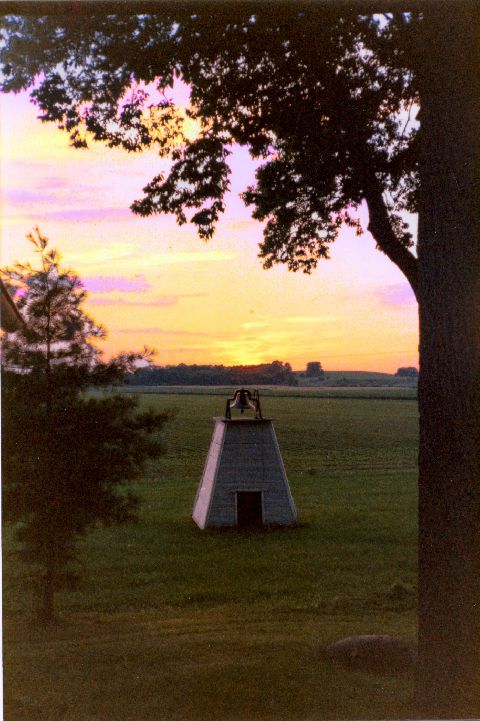
The view of the farm from Aunt Mary's kitchen window
One door from the kitchen opened into “the lavatory,” a deep, narrow room with wonderful built-in drawers along the side and even a tiny little square window at the back of the toilet which was painted in a shade of pink popular eighty years ago. Of special interest to me were the numerous toiletries and medicinal preparations residing there, each with its own with distinctive fragrance issuing from interesting glass bottles and beautifully papered cardboard boxes, all much more old-fashioned than anything I was used to seeing at home. There was a contraption (perhaps on the back of the door?) holding a long circular cotton towel on rollers that was pulled down to expose a clean, dry portion of the towel each time we washed our hands – I think commercial bathrooms used to have this kind of system when I was a girl, but I had never seen one in a home either before or since except for the one in Aunt Mary’s lavatory. I think I used to pretend I needed to go to the bathroom so I could go and poke around in this special little room and I am very certain my own child did exactly the same a generation later. It was all part of the irresistible and very special mystique of Aunt Mary’s house. Only recently I learned the lavatory had originally been built and used as a butler’s pantry, complete with an opening (the small window behind the toilet) into the dining room through which platters of food and serving pieces could be brought and removed!
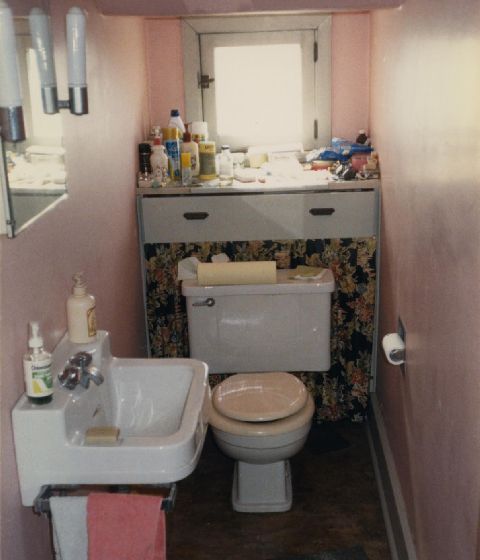
The butler's pantry-turned-lavatory (partial view)
Another kitchen door led into a room used by Aunt Mary and (when he was alive) Uncle Jim as a den, but I am pretty sure it was built to be the dining room. When I was small Uncle Jim used to sit there in state comfortably ensconced in his easy chair all wrapped up in blankets. Uncle Jim seemed positively ancient to me, and very ugly besides. I was astonished, as an adult, to discover photographs of him taken as a young man which revealed him to be exceptionally handsome! No wonder Aunt Mary fell in love with him, I thought to myself. The west-facing windows in this room were covered by old-fashioned roll-down window shades of dark green canvas, although there were curtains at these windows as well. The other furnishings, none of them particularly handsome, consisted mostly of sturdy, old-fashioned chairs. Although there was a television in the corner of the room my favorite part of the room was the fireplace, which sported a stiff, convex fire screen black metal resembling giant mesh. The mantel above it was full of bric-a-brac which I judged to be delightful. My favorite pieces were a pair of hand-painted china candlesticks and a thin, wooden cut-out toy made in the shape of a cowboy riding his horse with one arm flung out in the manner rodeo riders use to balance themselves of painted plywood. The cowboy and his horse sat perilously close to the edge of the mantel and rocked back and forth, creating the impression he would surely fall to the ground any second – but he never did. He was completely mesmerizing.
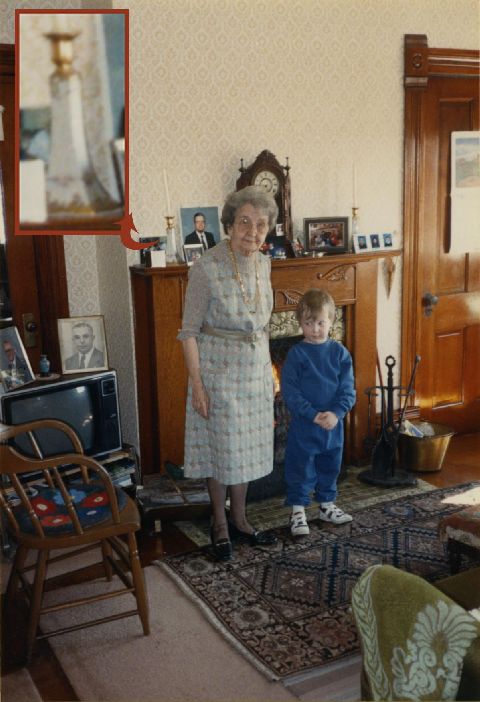
Aunt Mary and my little boy standing in front of the mantel in Aunt Mary's dining-room-turned-den. Photo was taken in the 1980s, by which time the rocking cowboy had been given to some of Aunt Mary's grandchildren, but you can still see the candlesticks (see inset)
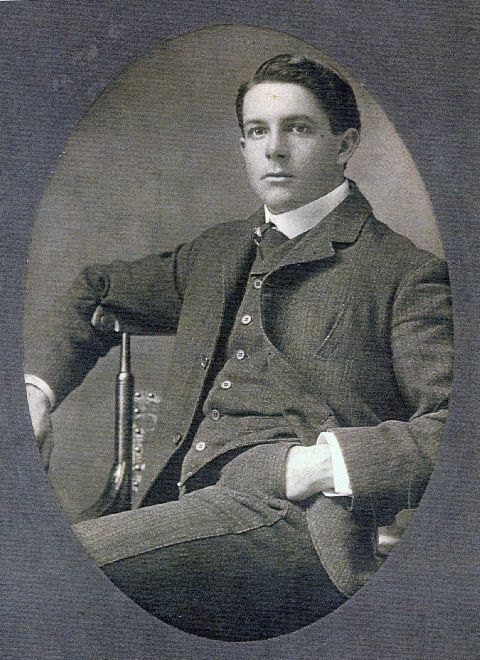
James Robert Tootle (1881-1970), my Great-Uncle Jim
There were, in addition to a fine old front hall, two other principal rooms on the ground floor of this farmhouse, each of which I found to be alluring in its own way. The living room was a large room, the floor of which was nearly entirely covered by one of the most beautiful oriental carpets I have ever seen. The walls of this room were papered in formal but faded wallpaper of cream and beige and bore the heads of two antlered deer killed by Uncle Jim on hunting trips to Pennsylvania. The tall, old-fashioned windows were hung with Battenberg lace curtains Aunt Mary said were so old she was afraid to take them down to launder because she was sure they would simply disintegrate. There were some pieces of old oaken furniture in the room, including a very ornate Art Nouveau secretary filled with gilt-trimmed books but the piece that got most of my attention was a glass-fronted bow-shaped china cabinet filled with Indian artifacts found on the Tootle farms interspersed with fine, delicate and richly decorated old pieces of china.
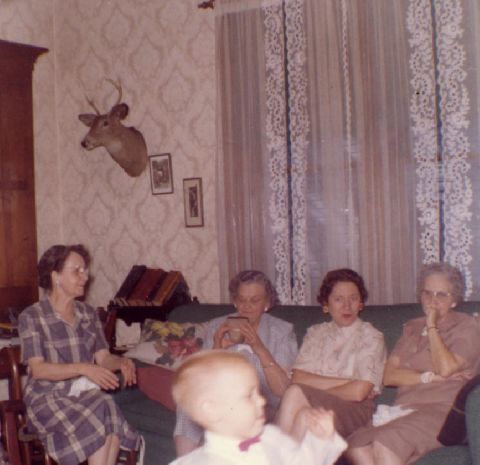
Deer head and Battenburg lace curtains are in evidence in this photo, taken in the late 1950s. Aunt Mary is the lady sitting on the far left.
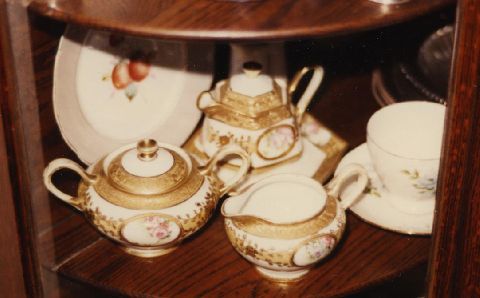
Some of Aunt Mary's beautiful china from the cupboard mentioned in the story
My favorite room of the house was unquestionably the parlor, located just off the front hall, which featured wide entrances (the pocket doors of which were perpetually open) into both the hall and the adjoining living room. The parlor had a triple bay window facing the front of the house (covered in matching Battenberg lace) and its walls were also papered in the same wallpaper as the living room. It too had an oriental-style carpet, this one of deep purple-red. (There must have literally been dozens of oriental rugs in the house, many of them small throw rugs, covering almost every square inch of flooring throughout the house.) The furnishings included a walnut Victorian parlor suite upholstered in muted blue and a small folding table in front of the fire with a picture of orange poppies on it I found hugely attractive. There was also an old trunk covered with a horsehair rug (Aunt Mary said it was used to keep them warm on the horse-and-buggy trips to take her and her sister to school in Chillicothe) and a curiously ornate black enamel chest inlaid with white mother-of-pearl. I thought this room was the cat’s meow, the absolute epitome of high-class décor, and when I was in it, I always felt like a princess. Years later, when I was grown with a child of my own, it was the place we sat while Aunt Mary related the stories of our family history. She opened the old chest one day to reveal dozens of priceless old sepia photographs, many of which she kindly gave to me – such as my beloved grandmother’s wedding picture and one of herself wearing her bridesmaid’s dress on that occasion.
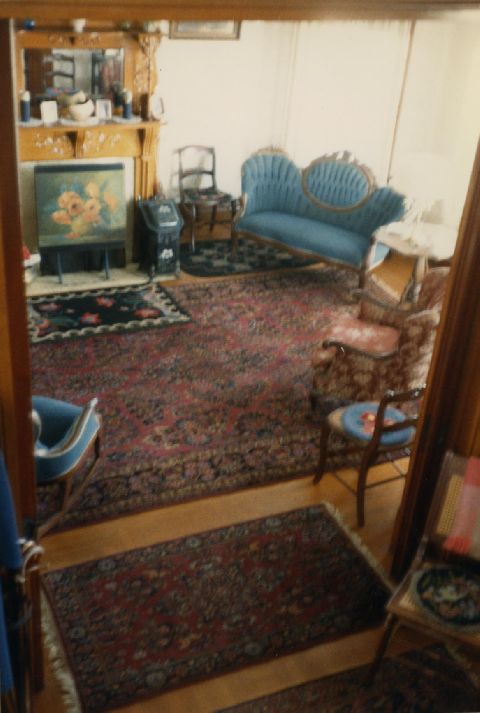
(Rather blurry) photo of Aunt Mary's parlor taken from front staircase
In the front hall, which was hung with old-fashioned wallpaper featuring ladies in long dresses and coaches with horses, hung the triple-mounted wedding photos of Aunt Mary and Uncle Jim, which I positively adored. There were lots of artifacts in the Arts and Crafts style placed here and there, a huge clay pot for storing umbrellas in being one such item. Halfway up the main staircase at the landing was a sunny, south-facing window which flooded the stairs with light. On the corner of this landing always sat a heavy ceramic stand in which was a huge Christmas cactus plant originally belonging to my great-grandmother Mandane that was over a hundred years old.
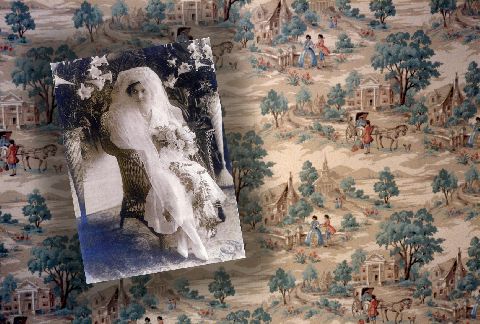
Photo of Aunt Mary's front hall wallpaper with one of her wedding photos, taken in April of 1917, superimposed over the wallpaper photo.
It seemed to me as if there were dozens of bedrooms upstairs, but I realize now, as an adult, there were really only five – but each one was distinctive. My favorite was the first room to the left off of the central hallway. For one thing, it faced south and was always filled with sunshine. Another of its charms was the abundance, both in number and in style, of fabrics and textiles in this room. There was always a beautiful quilt on the top of the bed, and at the foot of the bed resided, at least when I was a child, an old fabric-covered chest. On the floor was a beautiful blue and red Oriental rug on which sat another of Aunt Mary’s wonderful old wicker rocking chairs. I think there was also at least one handmade rug with designs on it as well, in addition to upholstery I liked, beautifully embroidered dresser scarves and bed linens, all of which gave the room a decided softness. It used to remind me of passages from Charlotte Bronte’s Jane Eyre. I believe this is the room my great-grandparents used as their bedroom before Aunt Mary and Uncle Jim took over the farm, but no matter whose room it was or had been, it was a place I found to be no less than magical.
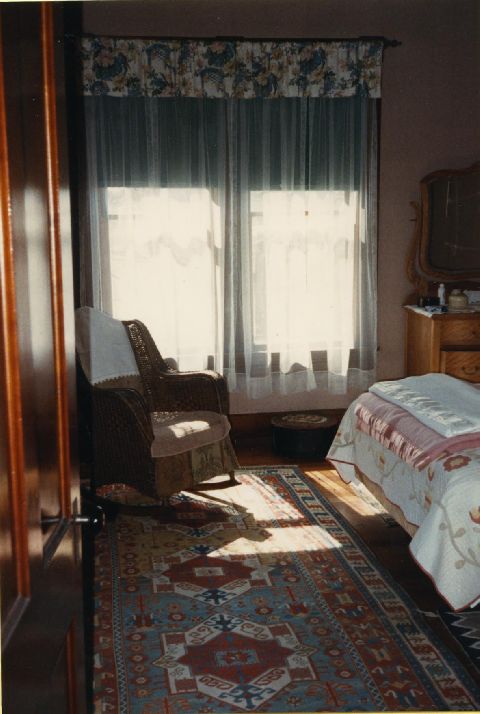
One view of my favorite bedroom in Aunt Mary's house
Aunt Mary’s room, on the opposite side of the hall, had a rug on the floor in which huge, lavender irises were somehow part of the weave; I’ve never seen another carpet even remotely like it. The object of fascination in her room, however, wasn’t the carpet but rather a small silver jewelry casket in the art nouveau style that sat on the corner of her dresser. This item positively terrified me! It was a jewel casket, which to my juvenile mind was the same thing as a coffin, and coffins were creepy in the extreme. It reminded me of dead things and horror movies. I hated to go in Aunt Mary’s room on this account and willed myself not to look as I passed her door on the way to other spots.
My other favorite upstairs room was called the sewing room; it was a small room papered in a brown wallpaper featuring pussywillows in bloom (or so I thought). Like so many other places in the house, it was full of antiques, including a very old sewing machine and lots of vintage needlework, including boxes and baskets of tatting and old embroidery. There were some old-fashioned toilet articles on a small dresser in that room as well. I found it to be a very interesting room, another place in which I was reminded of long-ago and far-away places existing in the pages of books I had read.
Near this little sewing room (which was also called “the maid’s room,” according to a recent conversation I had with Aunt Mary’s daughter-in-law Ruth) was the back stairs, another place that caused me to get the willies, principally because I’d been told my great-grandmother Mandane had suffered a heart attack on these stairs one day when my mother, who was only a girl at the time, was looking after her. That forever branded this stairway as being somehow sinister in my childish way of thinking. This fact, however, did not stop me from finding it a most interesting space, probably because it had in it a round window - a remarkably novel architectural detail in my estimation. The whole stairway was painted, except for the dark wooden trim, in a dismal shade of green which somehow added to its unsettling history.
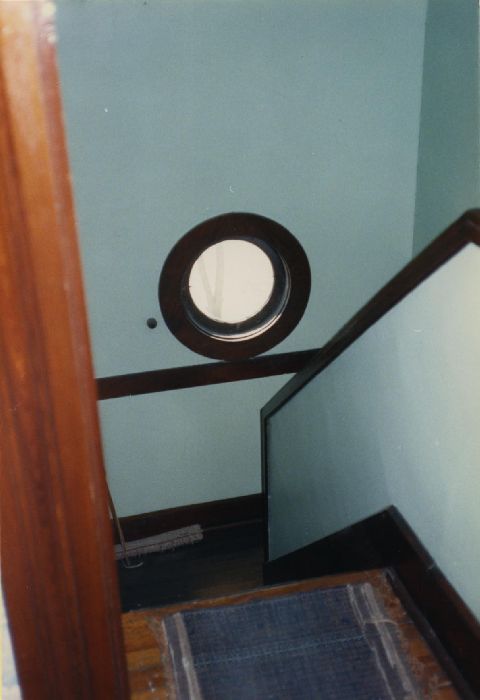
The back stairway where my great-grandmother had a heart attack sometime in the 1930s
Aunt Mary’s house was a veritable feast of visual delights, and I only wish everybody could have such a place in which to explore and play during their childhood, not to mention to have such a wonderful relation as was my dear great-aunt. After I grew up and watched my first Merchant-Ivory film (which happened to be A Room with a View, the 1985 production of E. M. Forster’s novel starring Emma Thompson), I always used to think I should write the set designers at Merchant-Ivory and tell them if they ever wanted to film a movie on location at a perfect, genuine turn-of-the-century American country house, I had just the place for them. Aunt Mary’s house seemed so unique it almost took on a life and personality of its own; I can’t think of it even now without strong emotion. I’m sure if I saw the house as it stands today, minus Aunt Mary and all her wonderful treasures, it would break my heart.
Comments 3
Susan,
Absolutely delightful! As I read about your Aunt Mary and her home I could imagine walking up the steps for a visit! Makes me want to take a ride down to Chillicothe via Rt 159! But then again, as you say, memories are the best.
Susan, you must have lots of emotions running through your being as you wrote this story. Precious memories preserved, as they should be.
Susan, what fantastic detail! Your journey through your memories must have taken you back to each of those "visits"into the rooms of Aunt Mary's home. Emotions of your childhood are better than going back to visit, as you said. Thanks for sharing and taking the time to let me "visit" as you took me through your guided tour to a place and time I could only have gone through reading contemporary literature of that time. Well done.




